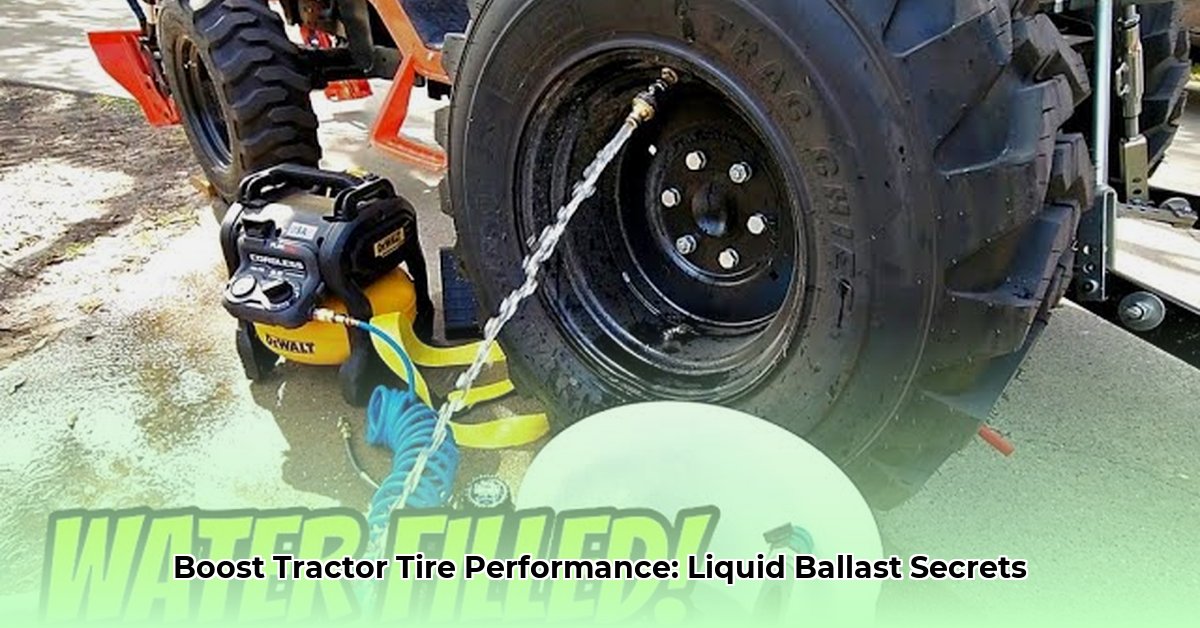
Choosing the right liquid ballast for your tractor tires significantly impacts performance, safety, and environmental responsibility. This guide provides a comparative review of common ballast options and a step-by-step process for safe filling and maintenance. For more information on tire inner tubes, check out this helpful resource: tractor tire inner tubes.
Understanding the Importance of Ballast
Why bother with liquid ballast? Adding weight to your tractor tires lowers the center of gravity, dramatically improving stability, especially on slopes or when hauling heavy loads. This enhanced stability translates directly to increased safety, reducing the risk of rollovers. Beyond safety, improved stability leads to better traction, minimizing wheel slippage. Less slippage means greater fuel efficiency and reduced wear and tear on your tractor and your fields. This ultimately leads to lower operating costs and improved soil health.
Liquid Ballast Options: A Comparative Review
Several liquids can serve as ballast, each with unique characteristics impacting its suitability for your specific needs and climate. The table below provides a comparison of popular options:
| Ballast Type | Freezing Point (°F) | Freezing Point (°C) | Toxicity Level (Explanation) | Corrosiveness Level (Recommendations) | Environmental Impact (Biodegradability, Disposal) | Cost per Gallon (USD) | Weight per Gallon (lbs) | Suitable Climate Zones | Suitable Soil Types |
|---|---|---|---|---|---|---|---|---|---|
| Water | 32 | 0 | Low (Generally non-toxic) | Low (Minimal corrosion) | Low (Easily biodegradable; dispose according to local regulations) | Very Low | 8.34 | Mild only | Most |
| Propylene Glycol Antifreeze | -35 | -37 | Low (Relatively non-toxic, biodegradable) | Low (Minimal corrosion) | Moderate (Biodegradable, but proper disposal crucial) | Moderate | 9.7 | Most | Most |
| Ethylene Glycol Antifreeze | -35 | -37 | Moderate (Toxic if ingested; requires careful handling) | Low (Minimal corrosion) | Moderate (Not readily biodegradable; specialized disposal required) | Moderate | 9.7 | Most | Most |
| Calcium Chloride | -50 to -60 | -46 to -51 | Low (Relatively non-toxic) | High (Highly corrosive; requires rim/tube protection) | Moderate (Can impact soil health; proper disposal crucial) | Low | 11.8 | Cold | Most (Avoid sensitive soils) |
| Beet Juice | 28 | -2 | Low (Generally non-toxic, biodegradable) | Low (Minimal corrosion) | Low (Biodegradable; dispose according to local regulations) | High | 9.7 | Mild | Most |
| Windshield Washer Fluid | Varies greatly | Varies greatly | Moderate to High (Variable composition; potentially toxic chemicals) | Low (Minimal corrosion) | Moderate (Variable composition; check individual components) | Low | Varies greatly | Mild only | Most |
Note: The cost per gallon and specific freezing points may vary depending on the supplier and region. Always check local regulations regarding ballast disposal. Never use windshield washer fluid as it contains a cocktail of chemicals with varying toxicity.
Choosing the Right Ballast: A Decision Tree
The best ballast depends on your specific needs. Use this decision tree to guide your selection:
What is your climate like?
- Mild: Proceed to Question 2.
- Cold: Choose Propylene Glycol Antifreeze (or Calcium Chloride with necessary precautions).
What's your budget?
- Tight: Choose Water (for mild climates only).
- Moderate: Choose Propylene Glycol Antifreeze.
- Flexible: Choose Beet Juice (environmentally friendly, but more costly).
What are your environmental concerns?
- High: Choose Beet Juice or Propylene Glycol Antifreeze.
- Moderate: Choose Propylene Glycol Antifreeze.
Safely Filling Your Tractor Tires: A Step-by-Step Guide
Improper filling can lead to damage and injury. Always follow these safety precautions:
Consult your tractor's manual: This is crucial for determining the recommended ballast type and maximum fill capacity for your specific tire model. Overfilling is dangerous and can void warranties.
Prepare your workspace: Ensure a clean, level work area free from debris.
Use a funnel: A funnel minimizes spills and keeps the ballast clean.
Add ballast gradually: Continuously monitor the fill level and avoid overfilling. Use a dipstick or other method to check the fluid level accurately.
Inspect and monitor: Check for leaks after filling. Regularly monitor fluid levels to maintain optimal tire pressure.
Disposal and Maintenance
Proper ballast disposal is vital for environmental protection. Different ballast types require different disposal methods. Always adhere to local regulations. Check for leaks regularly and maintain the appropriate fluid level.
Conclusion: Maximize Performance and Sustainability
Selecting the appropriate liquid ballast is critical for optimizing your tractor's performance while minimizing environmental impact and maximizing safety. This guide provides a framework for making an informed decision that aligns with your unique operational context. By carefully weighing the various options and adhering to safe handling practices, you can ensure your tractor operates efficiently and sustainably for years to come.